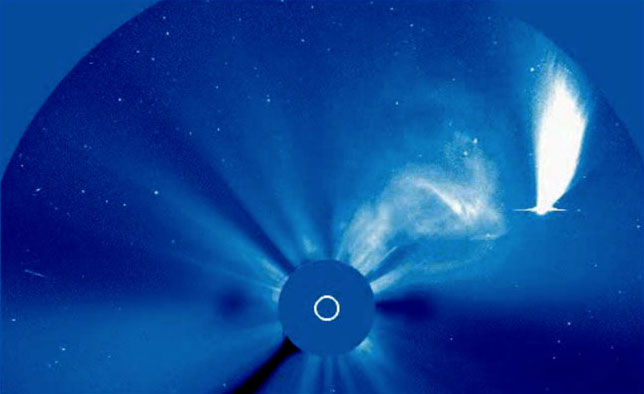|

by Wallace Thornhill
May 26, 2005
from
Thuntherbolts Website

Credit: Solar and
Heliospheric Observatory (SOHO)/ESA/NASA
Caption: the comet NEAT in 2003, meeting up with a coronal mass
ejection (CME) from the Sun.
When a coronal mass
ejection greeted Comet NEAT, space scientists called it a
“coincidence”. But in an electric universe such events deserve a
second look.
The comet NEAT was discovered November 2002 by NASA's Near Earth
Asteroid Tracking (NEAT) program. As the comet moved toward
“perihelion”, its closest approach to the Sun, astronomers were not
sure it would survive. The explosive destruction of
Comet Linear three years earlier,
at nine times NEAT’s distance from the Sun, underscored the danger
to comets from such a close passage around the Sun.
The Sun’s glare prevented observers on Earth from viewing NEAT’s
approach. But the
SOHO spacecraft, stationed between
Earth and the Sun, has an instrument called Large-Angle
Spectrometric Coronagraph (LASCO), which blocks the Sun’s brightest
light, permitting the satellite to record the comet’s dramatic swing
around the Sun.
As NEAT raced through the extended solar atmosphere, a large coronal
mass ejection (CME) exploded from the Sun and appeared to strike the
comet. The comet responded with a “kink” that propagated down the
tail.
A video clip of the event
can be seen here -
file takes up to 45
second to fully load (The disk in the
center is created by the coronograph as it blocks the Sun’s glare).
For astronomers, the event illustrated the dynamic interactions
between comets and the solar wind.
Scientists were quick to point out that meeting with ejected
material was a “chance encounter”. But was it? Though electrical
theorists assert no interpretation of the event at this time, they
reject the theoretical assumptions that prompt mainstream theorists
to dismiss out of hand any possibility that a comet could trigger an
eruption from the Sun.
If the Sun is a glow discharge at the center
of an electric field, and a comet carries a strong negative charge
together with a vast envelope of charged particles, the categorical
dismissal of mutual interactions is premature.
In fact, SOHO has recorded several instances of comets plunging into
the solar corona in “coincidental” association with CMEs.
Here we
see two comets grazing the Sun -
file takes up to 45
second to fully load
- followed by a particularly energetic
blast from a mass ejection.
Another instance of
two comets grazing
the Sun can be viewed here.
In a headline story, “Twin Comets Race To Death By Fire”, June 5,
1998, ScienceDaily.com reported:
“In a spectacular coincidence, a coronal mass ejection (CME)
accompanied by an erupting prominence occurred on the southwest limb
of the Sun within hours after the destruction of the comets. The CME
and prominence were probably unrelated to the comets, being instead
the product of weeks of intense magnetic activity in that region of
the Sun”.
Perhaps the
original source of this story (apparently a science
writer with NASA’s Goddard Space Flight Center), paid dearly for his
use of the word “probably” in the above paragraph.
Only an
electrical influence could justify any qualifications to the
assertion of a “spectacular coincidence”. But the scientific
mainstream allows for no electric force outside the Sun to have any
influence on the Sun’s atmospheric behavior.
SOHO scientists make the point explicit in their discussion of
sungrazing comets and CME’s:
“A popular misconception is that sungrazing comets cause solar
flares and CMEs (coronal mass ejections). While it is true that we
have observed bright comets approach the Sun immediately before
CME's/flares, there is absolutely no connection between the two
events. The sungrazer comets - in fact all comets - are completely
insignificant in size compared the Sun”.
The statement is reasonable if the issue of “connection” and
influence is decided by relative size. But from an electrical
viewpoint the disregard for the powerful electric force in space is
the greatest single mistake in the theoretical sciences today.
How
would
an electric Sun respond to the approach of a relatively small
but strongly charged object?
Comets typically display a bright coma
extending for hundreds of thousands of miles around the hidden
nucleus. They can also entrain an immense envelope of hydrogen gas.
We do not normally see the hydrogen envelopes of comets because
Earth’s atmosphere absorbs their light. But spacecraft can detect
them and measure them.
Electrical theorists suggest that the ability
of larger comets to hold their hydrogen clouds in place against the
solar wind is a good indicator of the comet’s powerful charge.
The influence of the
comet’s electrical field is far more
significant than its trivial mass in relation to the Sun. What will
occur electrically if the charge plasma or “atmosphere” of the comet
penetrates the insulating
double layer of the Sun’s plasma sheath?
An analogy might be the effect of a pebble from space penetrating
into the upper atmosphere of the Earth where the intruder’s plasma
trail short circuits the Earth’s electric field to cause a high
altitude discharge.
The issue has virtually nothing to do with the
respective masses of the Earth and the pebble. The disturbing image
of the
space shuttle Columbia being struck by a discharge that
followed its plasma trail through the upper atmosphere also comes to
mind.
Perhaps the observation of Nobel Laureate Hannes Alfvén, the
father
of plasma cosmology, can put the issue in context.
It was his
opinion that coronal mass ejections are caused by a breakdown or
breach of the Sun’s double layer - an event that provokes an explosive
exchange between the insulated plasma cell of the Sun and the plasma
of surrounding space.
For the electric theorists, such questions deserve conscientious
investigation, with attention to the electrical phenomena indicated
in both solar and cometary behavior.
|

